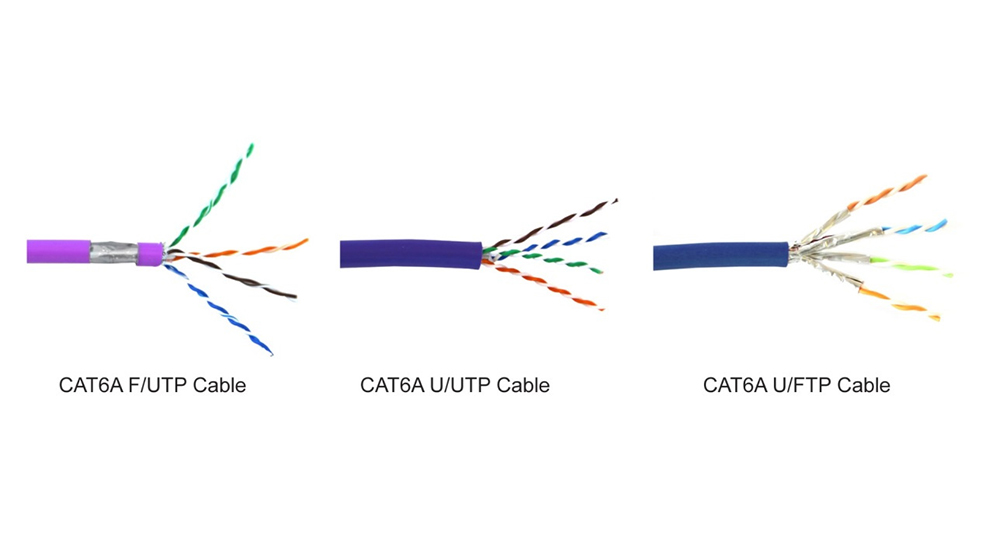
Comparison of CAT6 vs CAT6A cabling
CAT6
CAT6 cabling provides many advantages and benefits over CAT5E cabling infrastructure. When CAT6 was first introduced it was approximately 50% more expensive than CAT5E, which made it cost prohibitive for many installations. However, CAT6 costs have reduced substantially over a number of years to the point where costs are almost on par. CAT6 provides greater bandwidth over CAT5E and allows for higher data transfer rates. Therefore, CAT6 has now become the minimum standard for new cabling installations. As well as being able to easily support 1 Gbps network speeds, CAT6 can also support higher data rates of 10Gbps. However, 10Gbps is only supported over shorter distances of 37-55 metres.
CAT6A
CAT6A is capable of supporting data transfer rates of up to 10Gbps at a maximum bandwidth of 500MHz. CAT6A has additional and tighter twists, with additional insulation to reduce crosstalk. CAT6A is also backwards compatible with CAT6 and CAT5E, however, speeds are always limited and will perform to the lowest category cable or connector that is installed in the link. CAT6A is fast becoming the most cost effective solution as it is seen as a future-proof cable system. CAT6A components are used in Class EA networks as defined in ISO/IEC 11801 and TIA/EIA 568.
One of the perceived disadvantages of CAT6A is the actual size and weight of the cable. CAT6A was 50% larger when it originally appeared in 2008. Since then, cable sizes have been reduced and slimmed down by 10%. The additional weight increase also reduces the amount of cable that can fit into a cable tray and where you can place them. This results in a larger cable tray and conduits and smaller bundle size. The increased room is also required for the cable bend radius in the cable tray, patch panel and behind wall outlets.
Termination methods and times had also been seen to be a negative for CAT6A installation, however, new modular jacks and outlets which can be terminated in around 2-3 minutes have reduced installation time and cost.
One of the main arguments in favour of installing CAT6A infrastructure now is to future-proof the network. Therefore, if the planned lifetime of a new cabling system is five or more years, CAT6A should be considered as an option. If the planned lifetime of the network is ten years or more, CAT6A definitely appears to be the favoured solution.
In fact, when considering the use of CAT6A components in a 10Gbps, Class EA network, consider the following factors:
End users also have the option of selecting from either a shielded or an unshielded solution. Shielded CAT6A cable generally has an outer foil shield around each individual pair or around all 4 copper pairs. In addition, modular jacks, outlets and patch panels are also protected by a metal housing around these components. Each solution has its place, as well as its own set of benefits.
CAT6A cable is available in various configurations. Shielded and unshielded cables are often referred to as F/UTP (shielded) and U/UTP (unshielded) cable.
The first letters indicate the type of overall shield while the latter letters indicate the type of shielding on each pair and the balanced element.
CAT6A U/UTP means the cable consists of 4 unshielded twisted pairs and no outer shielding. CAT6A F/UTP means the cable consists of 4 unshielded twisted pairs, however, it contains an outer foil shield. This is a shielded cable. There is also CAT6A S/FTP (screened/foiled twisted pair) cable, normally a CAT7 cable that has four individually shielded pairs and an outer screen braid around all four pairs.
One of the latest additions to the CAT6A shielded cable range is a CAT6A U/FTP cable. This cable configuration has all four pairs individually shielded, rather than an outer foil shield. The overall test results and performance of this cable has been quite impressive.
CAT6 cabling provides many advantages and benefits over CAT5E cabling infrastructure. When CAT6 was first introduced it was approximately 50% more expensive than CAT5E, which made it cost prohibitive for many installations. However, CAT6 costs have reduced substantially over a number of years to the point where costs are almost on par. CAT6 provides greater bandwidth over CAT5E and allows for higher data transfer rates. Therefore, CAT6 has now become the minimum standard for new cabling installations. As well as being able to easily support 1 Gbps network speeds, CAT6 can also support higher data rates of 10Gbps. However, 10Gbps is only supported over shorter distances of 37-55 metres.
CAT6A
CAT6A is capable of supporting data transfer rates of up to 10Gbps at a maximum bandwidth of 500MHz. CAT6A has additional and tighter twists, with additional insulation to reduce crosstalk. CAT6A is also backwards compatible with CAT6 and CAT5E, however, speeds are always limited and will perform to the lowest category cable or connector that is installed in the link. CAT6A is fast becoming the most cost effective solution as it is seen as a future-proof cable system. CAT6A components are used in Class EA networks as defined in ISO/IEC 11801 and TIA/EIA 568.
One of the perceived disadvantages of CAT6A is the actual size and weight of the cable. CAT6A was 50% larger when it originally appeared in 2008. Since then, cable sizes have been reduced and slimmed down by 10%. The additional weight increase also reduces the amount of cable that can fit into a cable tray and where you can place them. This results in a larger cable tray and conduits and smaller bundle size. The increased room is also required for the cable bend radius in the cable tray, patch panel and behind wall outlets.
Termination methods and times had also been seen to be a negative for CAT6A installation, however, new modular jacks and outlets which can be terminated in around 2-3 minutes have reduced installation time and cost.
One of the main arguments in favour of installing CAT6A infrastructure now is to future-proof the network. Therefore, if the planned lifetime of a new cabling system is five or more years, CAT6A should be considered as an option. If the planned lifetime of the network is ten years or more, CAT6A definitely appears to be the favoured solution.
In fact, when considering the use of CAT6A components in a 10Gbps, Class EA network, consider the following factors:
- CAT6A is recommended for new Installations in Healthcare
- CAT6A is recommended for new installations in Education
- CAT6A provides enhanced performance for Power over Ethernet (PoE)
- CAT6A supports wireless systems that rely on 10Gig
CAT6A – Additional factors to consider
Shielded Vs Unshielded Cat 6aEnd users also have the option of selecting from either a shielded or an unshielded solution. Shielded CAT6A cable generally has an outer foil shield around each individual pair or around all 4 copper pairs. In addition, modular jacks, outlets and patch panels are also protected by a metal housing around these components. Each solution has its place, as well as its own set of benefits.
CAT6A cable is available in various configurations. Shielded and unshielded cables are often referred to as F/UTP (shielded) and U/UTP (unshielded) cable.
The first letters indicate the type of overall shield while the latter letters indicate the type of shielding on each pair and the balanced element.
CAT6A U/UTP means the cable consists of 4 unshielded twisted pairs and no outer shielding. CAT6A F/UTP means the cable consists of 4 unshielded twisted pairs, however, it contains an outer foil shield. This is a shielded cable. There is also CAT6A S/FTP (screened/foiled twisted pair) cable, normally a CAT7 cable that has four individually shielded pairs and an outer screen braid around all four pairs.
One of the latest additions to the CAT6A shielded cable range is a CAT6A U/FTP cable. This cable configuration has all four pairs individually shielded, rather than an outer foil shield. The overall test results and performance of this cable has been quite impressive.







Leave a comment